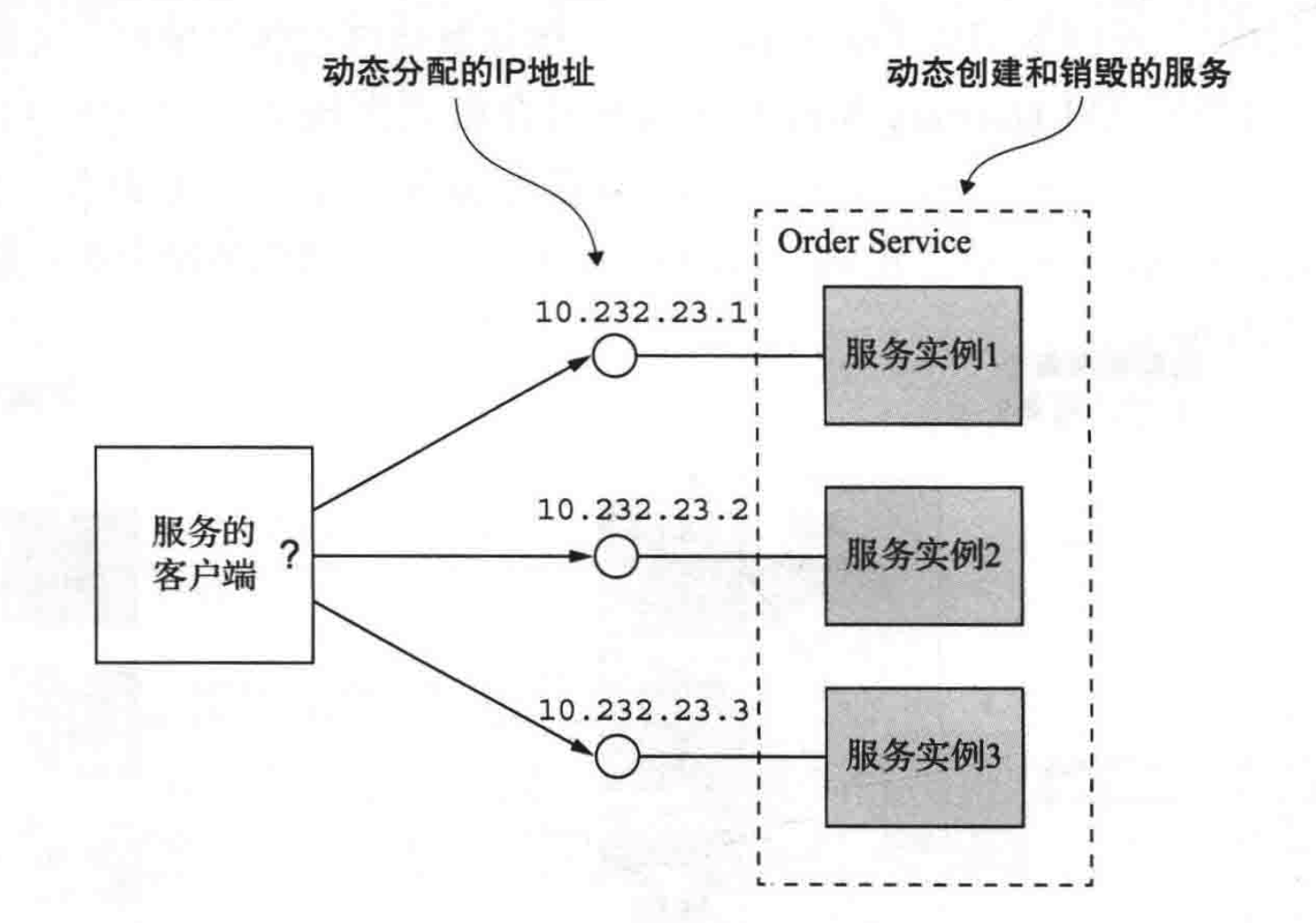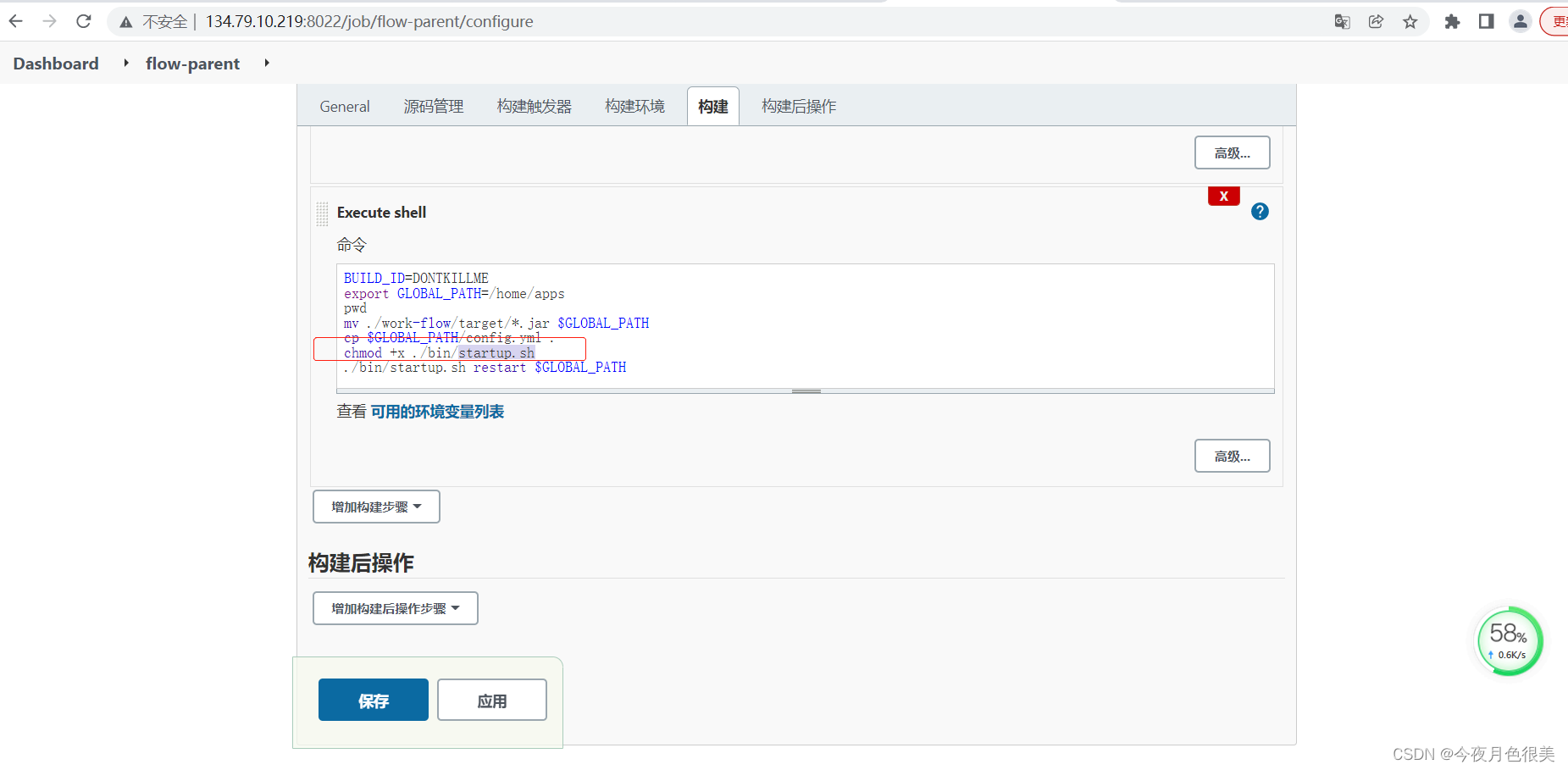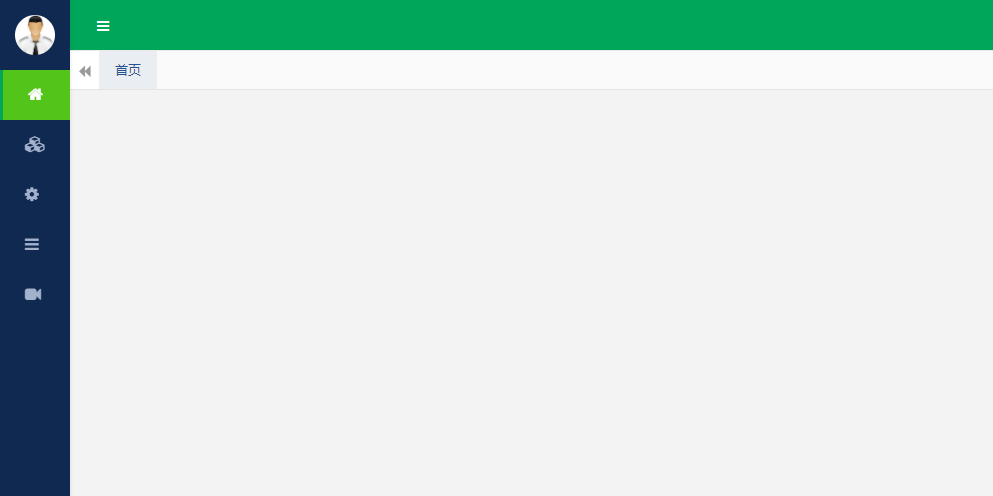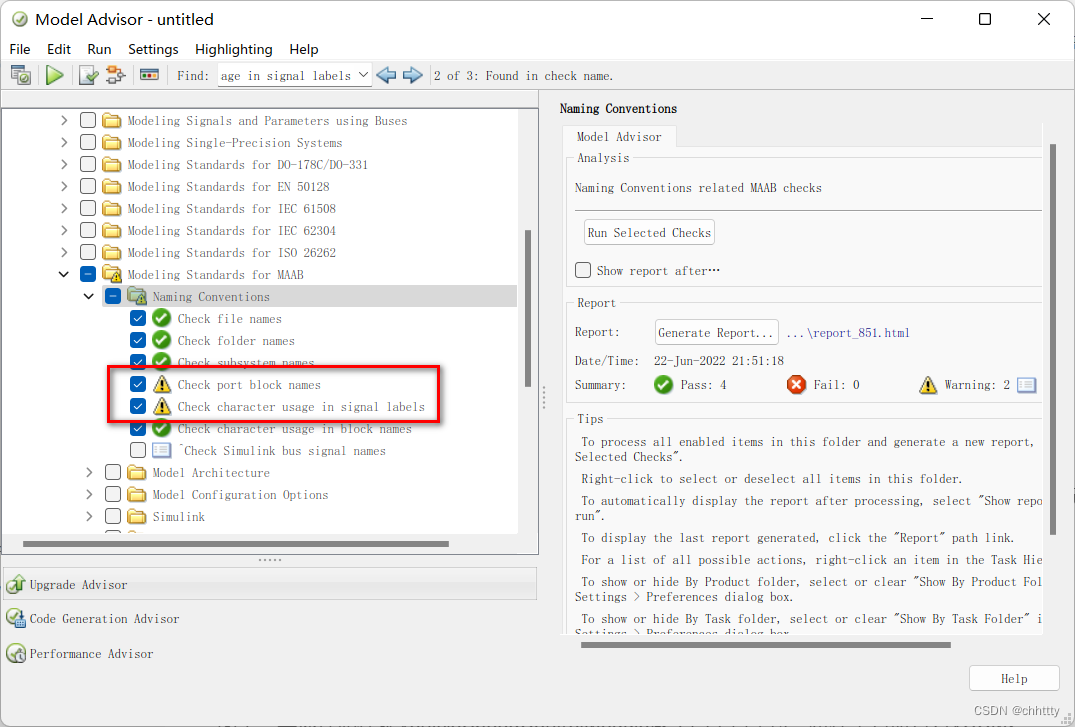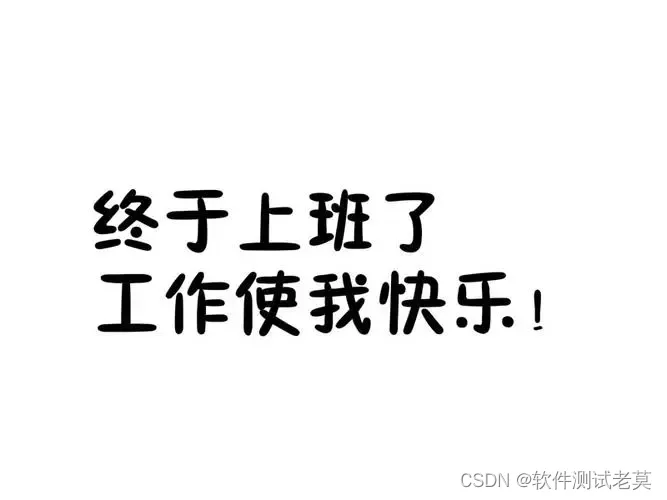当前位置:网站首页>Explore pointers and pointer types in depth
Explore pointers and pointer types in depth
2022-07-06 03:10:00 【iYYu】
Catalog
Preface
This is the advanced level of pointer , If you don't understand the primary pointer, please poke : Primary pointer .
The basic concept of pointer :
- A pointer is a variable , It's used to store the address , The address uniquely identifies a piece of memory space .
- The size of the pointer variable is 4/8 Bytes ( according to 32/64 Bit platform ).
- Pointers are typed , The type of pointer determines the pointer ± Step size of integer , The range that can be accessed during pointer dereference operation .
- Simple operation of pointer .
1. Character pointer
Among the pointer types, we know that one pointer type is character pointer char* ;
int main()
{
char ch = 'a';
char* pc = &ch;
*pc = 'b';
return 0;
}
It can also be written in the following form :
int main()
{
char* pc = "abcd";
// Is there a string stored in the pointer
printf("%s\n", pc);
return 0;
}

Not at all , It's actually a string First element address a Store to pointer pc in ,%s Just give the starting address of the string , Print all the way to \0 Before .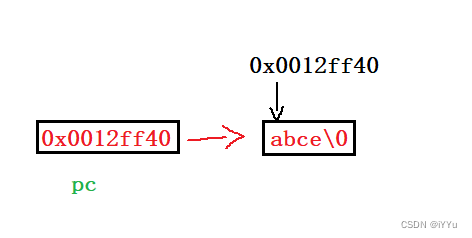
Because this string is a constant string , Cannot be modified , It is not safe to put pointer variables that are not decorated , Add const modification , So that it cannot be modified , In this way, the string is well protected .
const char* pc = "abcd";
An interview question :
int main()
{
char* p1 = "abcd";
char* p2 = "abcd";
char arr1[] = "abcd";
char arr2[] = "abcd";
if (p1 == p2)
puts("p1 == p2");
else
puts("p1 != p2");
if (arr1 == arr2)
puts("arr1 == arr2");
else
puts("arr1 != arr2");
return 0;
}
// What is the result of the output ?

So what is the difference between these two forms ? Drawing analysis :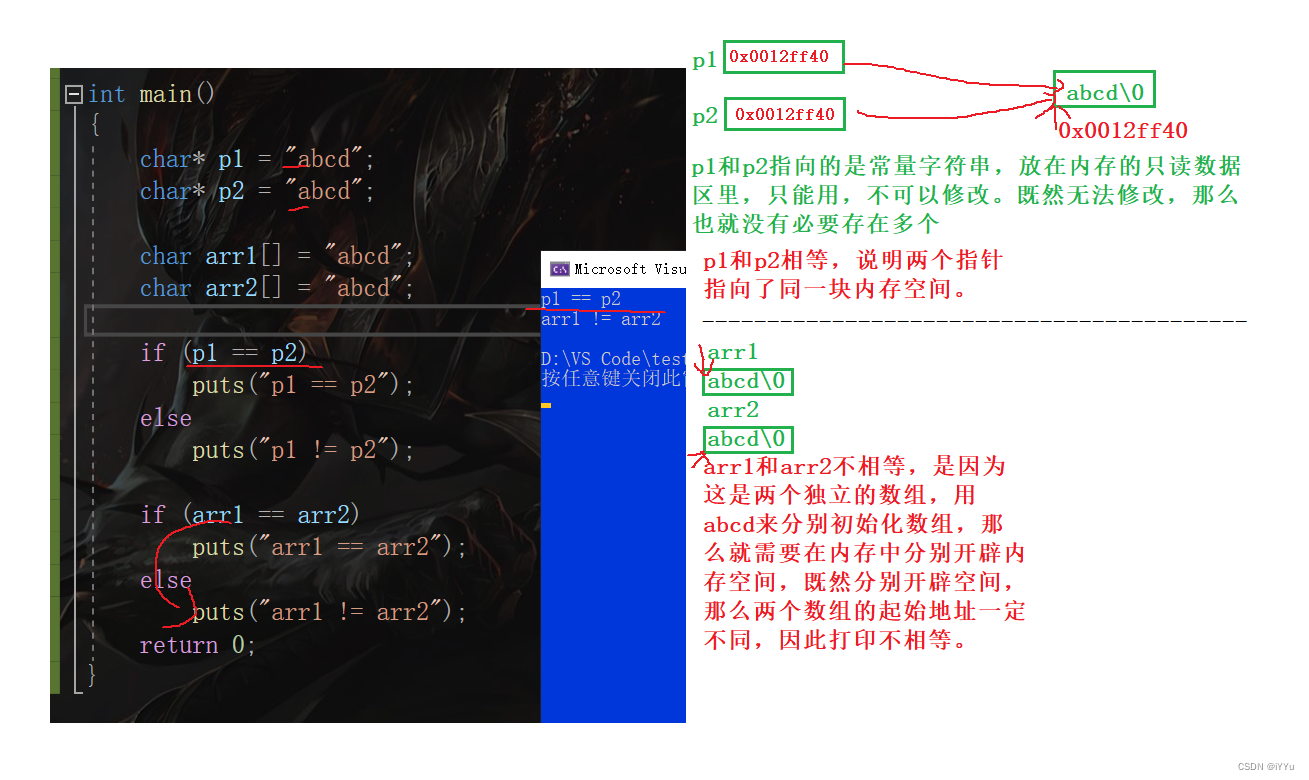
2. Array pointer
Before exploring array pointers , Let's review what is a pointer array :
Pointer array - It's an array . Is an array used to store pointer variables .
int arr[10];// Shape array
char brr[10];// A character array
...
int* crr[10];// Integer pointer array - An array of plastic pointers
char* drr[10];// Character pointer array
The function of pointer array :
int main()
{
int arr[] = {
1,2,3 };
int brr[] = {
2,3,4 };
int crr[] = {
3,4,5 };
// Define an array of pointers
int* prr[3] = {
arr, brr, crr };
// The array name is equivalent to the address of the first element
// Put the first three elements of the array in prr in
// It's the address , therefore prr The type of is integer pointer type
return 0;
}
This kind of writing , In fact, it is simulated as a two-dimensional array , How to understand this ?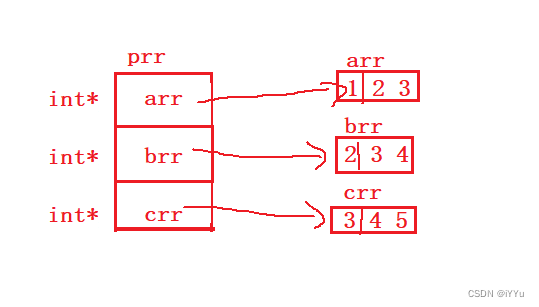
The meaning of that code , Know the layout of the pointer array , Then visit and print prr The contents of the array are almost the same as those of a two-dimensional array :
int main()
{
int arr[] = {
1,2,3 };
int brr[] = {
2,3,4 };
int crr[] = {
3,4,5 };
int* prr[3] = {
arr, brr, crr };
// Three elements , Corresponding subscript 0 1 2
// Find the corresponding first element address
for (int i = 0; i < 3; ++i)
{
// Then use a subscript to offset backward to find each element in the array
for (int j = 0; j < 3; ++j)
{
//prr[i][j] == *(prr[i] + j) == *(*(prr+i)+j)
printf("%d ", *(prr[i] + j));
}
printf("\n");
}
return 0;
}
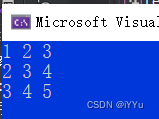
Use a pointer array to skillfully combine three one-dimensional arrays , It's like a two-dimensional array , This is a function of pointer array .
Two dimensional arrays are stored continuously in memory , These three one-dimensional arrays are not necessarily , So it's simulating a two-dimensional array .
2.1 Definition of array pointer
After understanding the pointer array , Next, explore array pointers :
Shaping the pointer - Pointer to the shape
Character pointer - Pointer to character
…
Array pointer - Is a pointer - Pointer to array .
What are the meanings of the following two statements :
int *p1[10];
int (*p2)[10];
//p1, p2 What are the differences ?
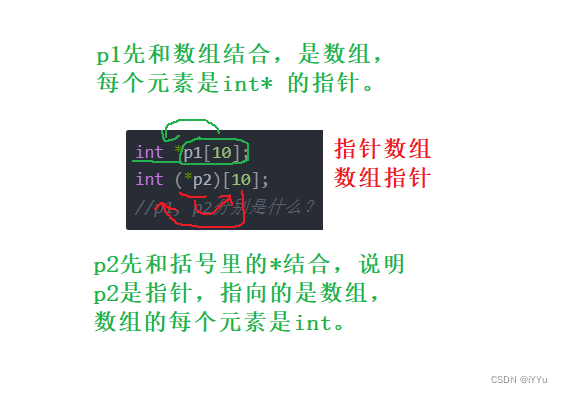
[ ] The priority of is higher than that of the asterisk , So we have to add () To guarantee p The first and * combination .
2.2 & Array name VS Array name
To figure out how array pointers are used , We must understand again Array name and & Array name The meaning of :
The array name is usually the address of the first element , But there are Two accidents :
- sizeof( Array name )
there arr It's the whole array , The total size of the array is calculated .
It must be internal A separate Put an array name
- & Array name
The array name here still represents the whole array ,& The array name takes out the address of the entire element .( Unit is byte )
What's the difference ?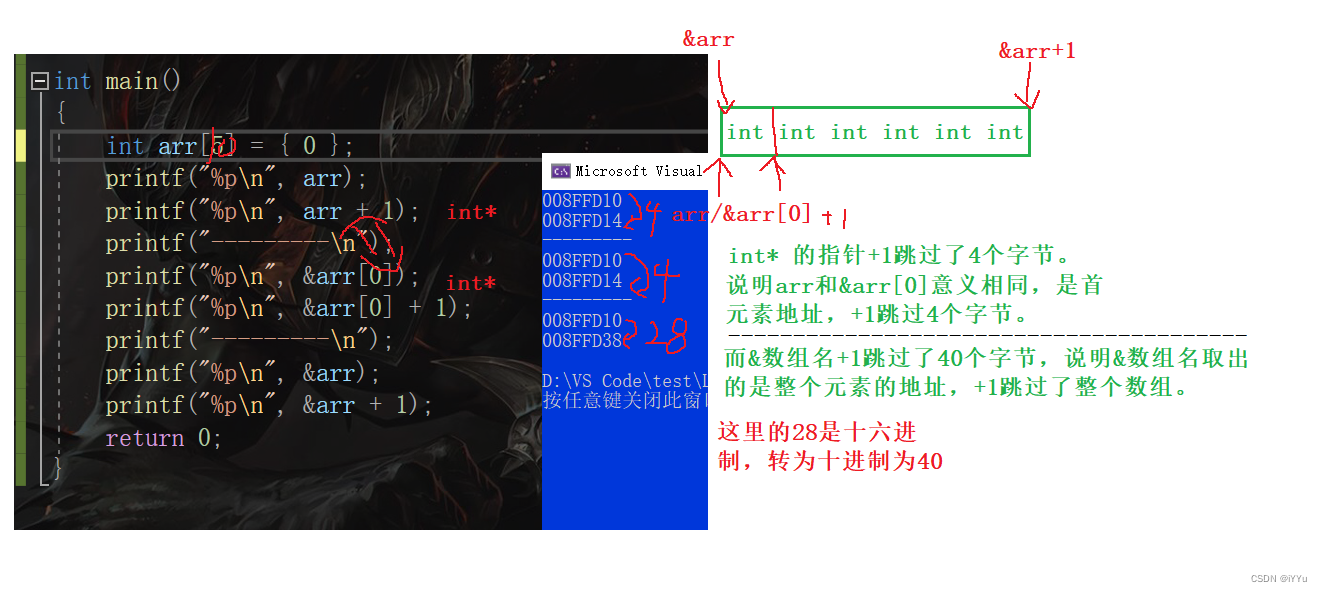
Code instructions :
int main()
{
int arr[5] = {
0 };
// The address of the first element of the array is placed in int* The pointer to
int* p1 = arr;
// Take the address of the entire array and put it in the array pointer p2 in
int (*p2)[5] = &arr;
// The difference between these two pointers :
//p1 The address of the first integer element is stored , Point to first element , Can't represent the entire array .
// and p2 The whole array is stored arr The address of , It points to an array .
return 0;
}
Removing the name is its type :int* \ int (*)[5].
The following square brackets must contain the number of elements of the array , Otherwise, it will warn .
2.3 Application of array pointer
Understand the basic concept of array pointer , Next, we will explore the usage of array pointers :
Print array elements :
int main()
{
int arr[5] = {
1,2,3,4,5 };
int (*p)[5] = &arr;
// The address of the entire array
for (int i = 0; i < 5; ++i)
{
printf("%d ", *(*p + i));
/// First, dereference p Found array arr The address of the first element
// namely *p == arr
// Address +i Find each element in the dereference backward offset
}
return 0;
}
This usage is awkward , In fact, it is very unreasonable .
The normal way of writing should be :
int main()
{
int arr[5] = {
1,2,3,4,5 };
int* p = arr;
for (int i = 0; i < 5; ++i)
{
printf("%d ", *(p + i));
// The address of the first element p The pointer to
//p+i Find the address of each element
// Dereference found element
}
return 0;
}
Compared with the first method, the clarity of this method is self-evident .
The function of array pointer is not reflected in one-dimensional array , In two-dimensional or multi-dimensional arrays, array pointers are wonderful .
Next, explore the correct usage of array pointers .
Function to print a two-dimensional array :
// There are two ways of writing :
// The array is passed to the parameter group and received :int arr[3][4]
// The first element address is actually uploaded from the array parameters
// Here, how to write formal parameters in the form of pointers ?
void print(???, int r, int c)
{
}
int main()
{
int arr[3][4] = {
1,2,3,4,2,3,4,5,3,4,5,6 };
print(arr, 3, 4);
return 0;
}
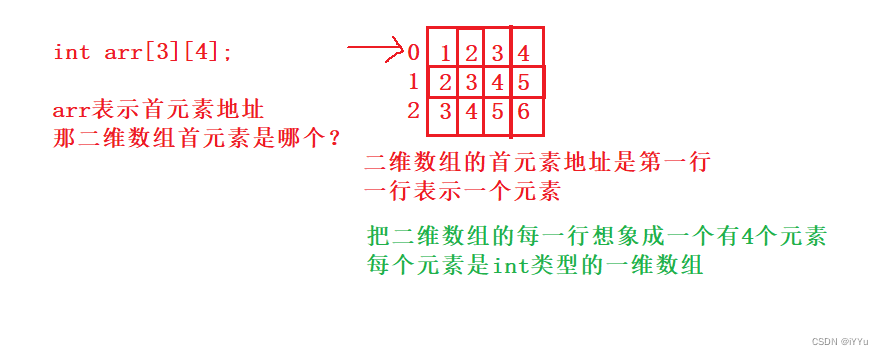
Since the name of a two-dimensional array is the address of its first row of one-dimensional array , Then the formal parameter should set a pointer to the address of one-dimensional array :
(*pa) Is a pointer , Pointing to the array , The array has four elements (*pa)[4], Each element is int type
int (*pa)[4]
void print(int (*pa)[4], int r, int c)
{
//pa+i Point to i That's ok
for (int i = 0; i < r; ++i)
{
//pa+i Dereference to get the address of the first element of the current line
for (int j = 0; j < c; ++j)
{
// First element address +j Then dereference to get the current element
printf("%d ", *(*pa + i) + j));
//printf("%d ", pa[i][j]);
}
printf("\n");
}
}
int main()
{
int arr[3][4] = {
1,2,3,4,2,3,4,5,3,4,5,6 };
print(arr, 3, 4);
return 0;
}
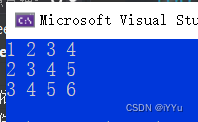
Why array pointers +1 Skip an array :
pa The type of is an array pointer :int (*)[4]
pa Is to point to an array , Array 4 A plastic element
therefore pa+1 Skip one 4 individual int Array of elements .
Having learned about pointer arrays and array pointers, review and see what the following code means :
int arr[5];
//arr Is an integer array
int *parr1[10];
//parr1 Is an array of integer pointers
int (*parr2)[10];
//parr2 Is an integer array pointer
int (*parr3[10])[5];
//parr3 Is an array that holds array pointers
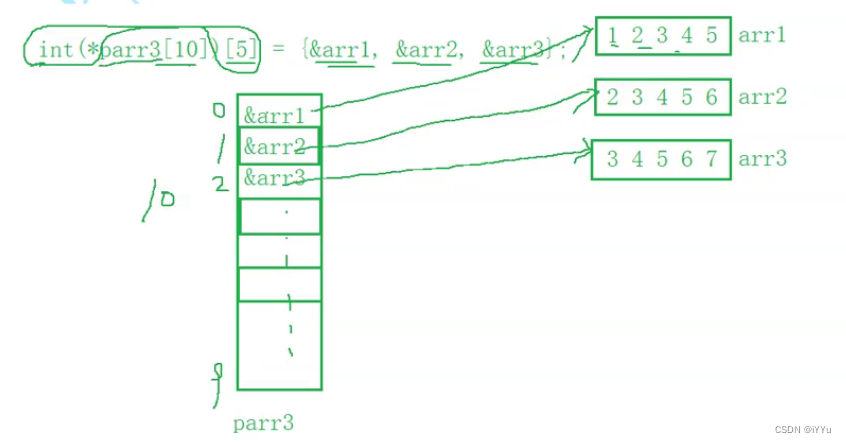
int main()
{
int arr[] = {
1,2,3 };
int brr[] = {
1,0,1 };
int crr[] = {
1,2,3 };
int (*parr[3])[3] = {
&arr, &brr, &crr };
for (int i = 0; i < 3; ++i)
{
int (*pa)[3] = parr[i];
// hold parr The elements of the array are assigned to the array pointer in turn pa
for (int j = 0; j < 3; ++j)
{
//pa It's No i The address of an array
// First, dereference to get the address of the first element of the current array
// recycling j Offset dereference to get each element separately
printf("%d ", (*pa)[j]);
}
printf("\n");
}
return 0;
}
3. Array parameter passing and pointer parameter passing
When writing code, it is inevitable to 【 Array 】 perhaps 【 The pointer 】 Pass to function , How to design the parameters of the function ?
3.1 One dimensional array parameters
void test(int arr[])//ok?
{
}
void test(int arr[10])//ok?
{
}
void test(int *arr)//ok?
{
}
void test2(int *arr[20])//ok?
{
}
void test2(int **arr)//ok?
{
}
int main()
{
int arr[10] = {
0};
int *arr2[20] = {
0};
test(arr);
test2(arr2);
return 0;
}
The above parameter transfer forms are correct .
3.2 Two dimensional array parameters
void test(int arr[3][5])//ok?1
{
}
void test(int arr[][])//ok?2
{
}
void test(int arr[][5])//ok?3
{
}
void test(int *arr)//ok?4
{
}
void test(int* arr[5])//ok?5
{
}
void test(int (*arr)[5])//ok?6
{
}
void test(int **arr)//ok?7
{
}
int main()
{
int arr[3][5] = {
0};
test(arr);
return 0;
}
2:error, reason : Two dimensional array parameters , Function parameter design can only omit the first [ ] The number of .
Because for a two-dimensional array , I don't know how many lines there are , But you have to know how many elements in a row .
So it's easy to calculate .
4:error, reason : The array name of a two-dimensional array represents the address of the first element , Is the address on the first line .
The first line can be seen as containing 5 The address of an array of integer elements , Since the address of the array is placed at the first level, the pointer must be wrong , You should use array pointers .
5:error, reason :arr The first and [ ] combination , It's an array , Each element is int*, So wrong .
7:error, reason : The secondary pointer stores the primary pointer , The address of the array cannot be stored in the secondary pointer .
3.3 First level pointer parameter transfer
If the formal parameter part of the function is a first-order pointer , So what can the actual parameters be written when calling ?
void print(int *p)
{
}
int main()
{
> int a = 10;
print(&a);
> int* pa = &a;
print(pa);
> int arr[10];
print(arr);
return 0;
}
If the formal parameter is a first-order pointer , The argument can be passed to the address of the shaping 、 Integer pointer and array name ( It's all pointers ).
3.4 The secondary pointer transmits parameters
If the formal parameter part of the function is a secondary pointer , Then what can the actual parameters be written when calling ?
void test(int** ptr)
{
}
int main()
{
int* p1;
test(&p1);
int* *p2 = &p1;
test(p2);
int* arr[10];
test(arr)
return 0;
}
A formal parameter is a secondary pointer , Arguments can : Take the first level pointer of the address 、 Second level pointer and pointer array .
4. A function pointer
An array pointer is a pointer to an array , and A function pointer is a pointer to a function .
& The array name takes out the address of the array :
int main()
{
int arr[5] = {
0 };
int(*pa)[5] = &arr;// Array pointer
return 0;
}
that & Is the address of the function taken out by the function name ?
int Add(int x, int y)
{
return x + y;
}
int main()
{
// Get the address of the function
printf("%p\n", &Add);
return 0;
}
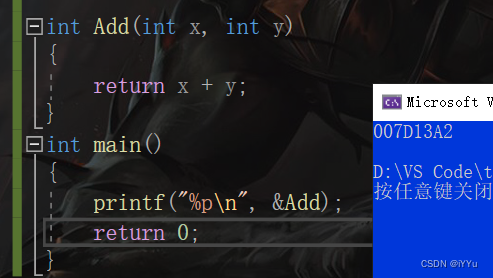
So functions also have addresses .
For functions :& Function name and function name are the address of the function .
So withprintf("%p\n", Add);There is no difference between .
Get the address of the function , Save it , How to write ?
In fact, it is very similar to array pointers :
(*pf) Indicates that it is a pointer ,(*pf)() This pair of parentheses indicates that it refers to a function ( Function call operator ()), The function parameter type it points to is int, int, The return type is int,int (*pf)(int, int), The pointer pf Stored functions Add The address of .
int (*pf)(int, int) = &Add
int (*pf)(int x, int y) The parameter name can be omitted without writing , As long as the parameter type .
Since there is the type of function pointer , Then it must have its function , Next, explore the role of function pointers :
Take out a plastic address and put it in a pointer , Dereference the pointer to find and modify it , For function pointers , It's the same thing .
For example, using pointers to call functions indirectly :
int Add(int x, int y)
{
return x + y;
}
int main()
{
// Call directly
//int ret = Add(2, 3);
// Take the address and put it in the pointer pf in
int (*pf)(int, int) = &Add;
// This & The symbol can be omitted
// Call indirectly with pointer
// Dereference pointer , Pass parameters while calling functions
int ret = (*pf)(2, 3);
printf("%d\n", ret);
return 0;
}
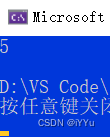
notes : This kind of writing is also right ,
int ret = pf(2, 3);, Don't write * Number , Exactly equivalent toint ret = Add(2, 3);This explains why you can omit the asterisk , The asterisk above is for easier understanding .
But if you write the form above, you must use parentheses , Otherwise, it's not a function pointer .
Through the understanding of the above code , You may feel that the function pointer is a little superfluous , It's all the same , Calling by pointer also complicates the code , In fact, function pointers are more complex in this environment .
But function pointers are very useful in other environments , After that, I will introduce its other wonderful functions .
Let's first look at two interesting pieces of code :
// Code 1
( *( void (*)() )0 )();
// Code 2
void ( *signal(int , void(*)(int) ) )(int);
first :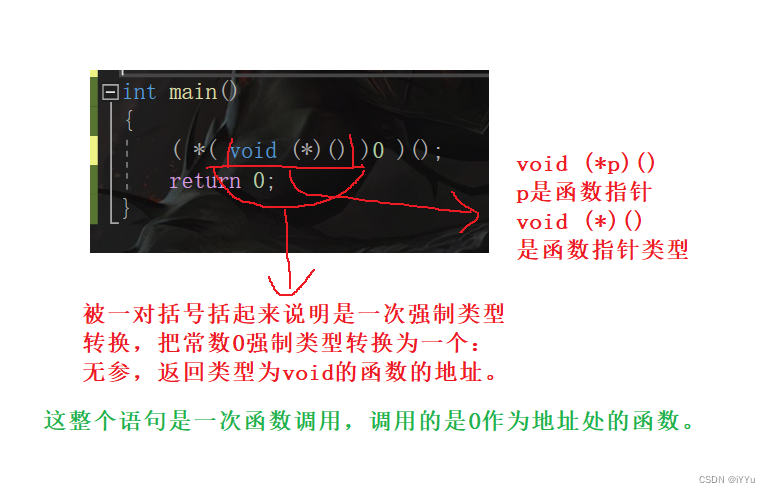
the second :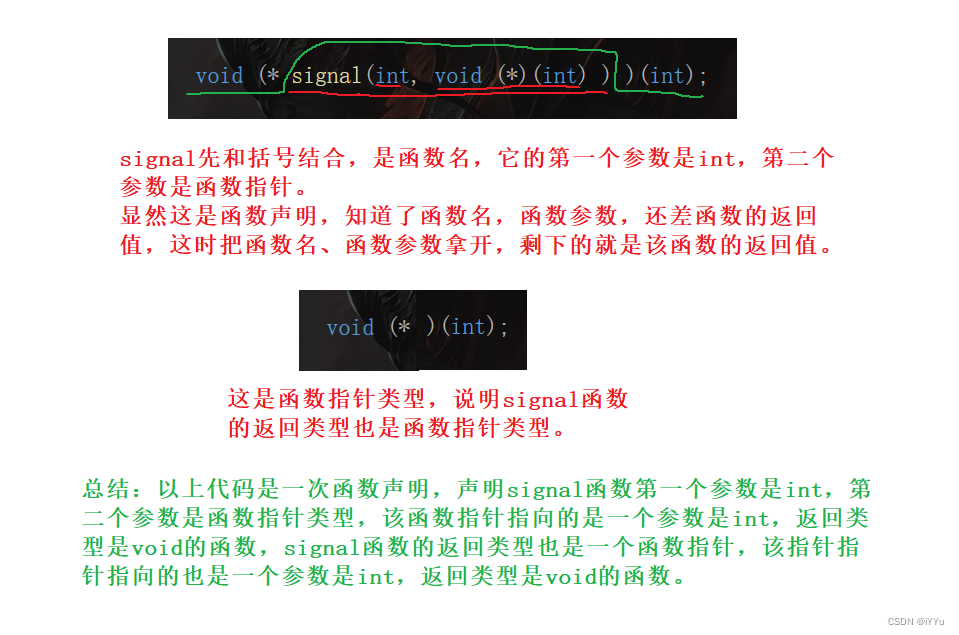
Although it explains its meaning , But it's not too convenient to understand , Function parameters are function pointers , The return type is also a function pointer , Some winding .
You can use typedef To optimize the function declaration :
typedef unsigned int u_int;
// It's just a way of unsigned int Rename it to u_int
// Optimize the function pointer
void(*)(int)
// hold void (*)(int) The type is renamed to pf_t
Now modify the code :
typedef void (*pf_t)(int);
int main()
{
void (* signal(int, void (*)(int) ) )(int);
pf_t signal(int, pf_t);
return 0;
}
Here is the function of function pointer .
Write a simple calculator , This computer contains addition and subtraction ( The principle of multiplication and division is the same , Just understand its meaning , No longer implemented ):
// choose 1 Add
// choose 2 Subtraction
// choose 0 sign out
int Sub(int x, int y)
{
return x - y;
}
int Add(int x, int y)
{
return x + y;
}
void menu()
{
puts("*******************");
puts("***** 1. Add ****");
puts("***** 2. Sub ****");
puts("***** 0. exit ****");
puts("*******************");
}
int main()
{
int input = 0;
do
{
menu();
printf(" Please input function :");
there:
scanf("%d", &input);
int x = 0;
int y = 0;
switch (input)
{
case 1:
printf(" Please enter two operands :");
scanf("%d %d", &x, &y);
printf("%d\n", Add(x, y));
break;
case 2:
printf(" Please enter two operands :");
scanf("%d %d", &x, &y);
printf("%d\n", Sub(x, y));
break;
case 0:
printf("Exit calcu!\n");
break;
default:
printf(" error ! Please re-enter :\n");
goto there;
break;
}
} while (input);
return 0;
}
test result :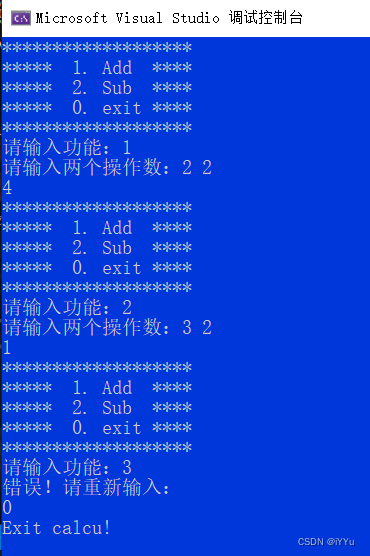
Although the running result is ok , But it is not difficult to find that the implementation of the code is somewhat redundant , If you add multiplication and division, the repeated part of the code will be more .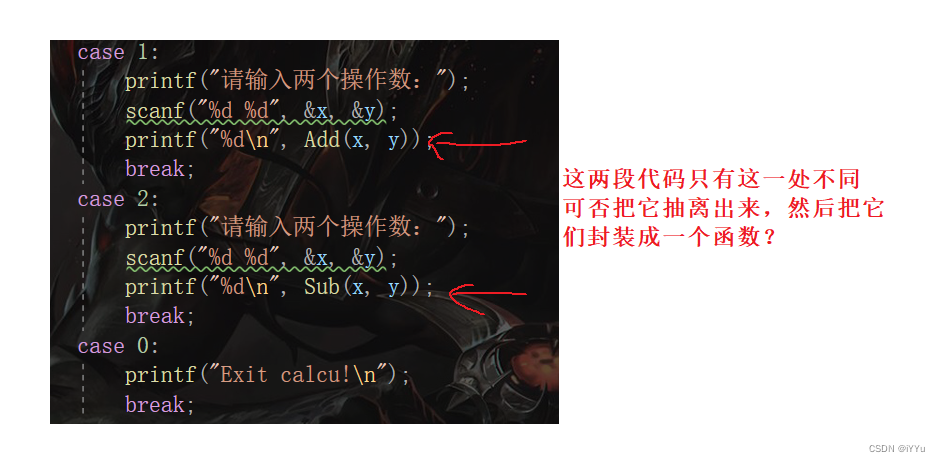
At this time, it reflects the cleverness of function pointers :
Encapsulate a function calc To be responsible for adding and subtracting , Because the function name is the function address , You can take the address of the function that implements addition and subtraction as calc Parameters of , choice 1 Pass in Add Address of function , choice 2 Pass in Sub The address of , Then use the function pointer to find and call the current function .
void menu()
{
puts("********************");
puts("***** 1. Add *****");
puts("***** 2. Sub *****");
puts("***** 0. exit *****");
puts("********************");
}
int Sub(int x, int y)
{
return x - y;
}
int Add(int x, int y)
{
return x + y;
}
// Calculation
// Function pointer should be set for formal parameter
void calc(int (*pf)(int, int))
{
int x = 0;
int y = 0;
printf(" Please enter two operands :");
scanf("%d %d", &x, &y);
printf("%d\n", pf(x, y));
}
int main()
{
int input = 0;
do
{
menu();
printf(" Please input function :");
there:
scanf("%d", &input);
int x = 0;
int y = 0;
switch (input)
{
case 1:
calc(Add);
break;
case 2:
calc(Sub);
break;
case 0:
printf("Exit calcu!\n");
break;
default:
printf(" error ! Please re-enter :\n");
goto there;
break;
}
} while (input);
return 0;
}
Here, function pointers are cleverly used to achieve relatively simple code , If there is no concept of function pointer , Of course, there is no way to write in this form .
This form is also called a callback function , Through function pointers , Call the function it points to back at the appropriate time .
5. Function pointer array
Putting the function pointer in the array is the function pointer array .
The above two functions Add and Sub, Because the function name is the address of the function , Put these two functions into the array , The elements of an array are function pointers , And arrays are called function pointer arrays :
Let's deduce how to write its type , Actually, it is similar to function pointer :
int (*pf)(int, int) = Add;- This is the function pointer .
Actually pf Replace it with an array , It's an array of function pointers :int (*arr[2])(int, int) = {Add, Sub};( The number of elements can be omitted ).
arr The first and [ ] combination , It's an array , Put the array name arr and [ ] move aside , It's the type of it : A function pointer , Each element of it is a function pointer .
int Sub(int x, int y)
{
return x - y;
}
int Add(int x, int y)
{
return x + y;
}
int main()
{
// Function pointer array
int (*arr[2])(int, int) = {
Add, Sub};
return 0
}
Access this array :
int Sub(int x, int y)
{
return x - y;
}
int Add(int x, int y)
{
return x + y;
}
int main()
{
int (*arr[2])(int, int) = {
Add,Sub };
for (int i = 0; i < 2; ++i)
{
int ret = arr[i](8, 4);
printf("%d\n", ret);
}
return 0;
}
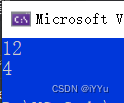
Since there is a form of function pointer array , It will certainly have its role , Use this array , Then optimize the calculator above .
You don't just want to add, subtract, multiply, divide , Also want to achieve x & y、x | y、x ^ y… wait
If you want to add more functions , So the corresponding case Statements are also bound to increase , The whole code is not easy to read , What can be done to simplify the code ?
At this time, use the function pointer array , Can greatly optimize the code , Make it very concise .
Code implementation : First, you need to create a function pointer array -int (*arr[])(int, int) = { 0,Add,Sub };
Put one at the front 0, Push the subscript of the two functions back by one , Therefore, it can be based on input The entered value directly corresponds to its subscript .
If input = 0; Exit the calculator directly , If input>=1 && input <=2, Use the array subscript to realize the corresponding · Function call , Otherwise, re-enter , Code implementation :
void menu()
{
puts("********************");
puts("***** 1. Add *****");
puts("***** 2. Sub *****");
puts("***** 0. exit *****");
puts("********************");
}
int Sub(int x, int y)
{
return x - y;
}
int Add(int x, int y)
{
return x + y;
}
int main()
{
int (*pfArr[])(int, int) = {
0,Add,Sub };
int input = 0;
int x = 0;
int y = 0;
do
{
menu();
printf(" Please select the function :");
there:
scanf("%d", &input);
if (!input)
{
puts("Exit calc!");
}
else if (input >= 1 && input <= 2)
{
printf(" Please enter two operands :");
scanf("%d %d", &x, &y);
int ret = pfArr[input](x, y);
printf("%d\n", ret);
}
else
{
puts(" Please re-enter !");
goto there;
}
} while (input);
return 0;
}
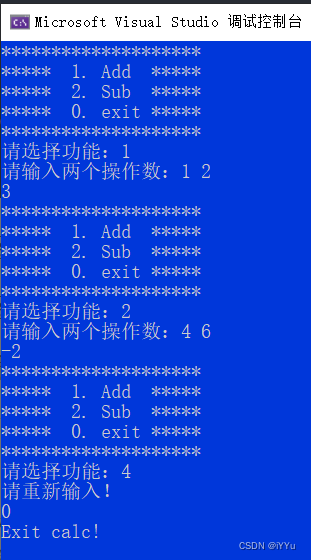
Very clever , Using function pointer array greatly simplifies the code .
If you want to add some functions later , You only need to implement the functions to be added , Add the function name to the array , Modify the judgment conditions again , It is very convenient to call and the code is simple .
6. A pointer to an array of function pointers
Function pointer array , It's also an array , Then there will be its address , Get the address of the array , It should be stored to point 【 Function pointer array 】 The pointer to , Then how to write the form of the pointer ?
int (*pfArr[])(int, int) = { 0,Add,Sub };This is an array of function pointers , Change according to this form :
First, it's a pointer (*ppfArr), It points to an array (*ppfArr)[ ], Each element of the array is a function pointer ( *(*ppfArr)[ ] )(), The argument to the function is int, int, The return value is intint ( *(*ppfArr)[] )(int, int) = &pfArr;
This is the pointer to the array of function pointers .
int main()
{
// This is an array of function pointers
int (*pfArr[])(int, int) = {
0,Add,Sub };
// A pointer to an array of function pointers
int (*(*ppfArr)[3])(int, int) = &pfArr;
return 0;
}
Since it's a pointer , It can also be stored in an array , That is to say 【 A pointer to an array of function pointers 】 Array of , This is also an array , Since it is an array …
7. Callback function
A callback function is a function called through a function pointer . If you put a pointer to a function ( Address ) Pass as argument to another function , When this pointer is used to call the function it points to , Let's just say this is a callback function .
The callback function is not called directly by the function's implementer , It's called by another party when a particular event or condition occurs , Used to respond to the event or condition .
First introduced qsort Function usage .
qsort yes C A library function of language , A sort function implemented using the idea of quick sort , It can sort any data .
qsort Parameters :void qsort( void *base, size_t num, size_t width, int (*cmp)(const void *e1, const void *e2 ) );
Four parameters :void* base- The starting position of the data to be sortedsize_t num- Number of elements of data to be sortedsize_t width- The size of the data element to be sorted ( byte )int (*cmp)(const void *e1, const void *e2 )- A function pointer ( Comparison function ), Call the function pointed to by this pointer , Parameters e1 and e2 Is the address of the two elements to be compared , Therefore, any type of data in this function can be compared .Be careful : The fourth function pointer points to a function whose parameters are
void*The pointer to , andvoid*The pointer to is a pointer without a specific type , Can receive any type of address , And because of this , thereforevoid*The pointer of cannot be dereferenced , Also can not ± The operation of integers ( Because I don't know what kind of address it is , The energy is set tovoid*type ), Therefore, you need to cast the type to the target type pointer .The return value of the comparison function :
utilize qsort To sort arrays :
int cmp_int(const void* e1, const void* e2)
{
return (*(int*)e1 - *(int*)e2);
}
int main()
{
int arr[] = {
9,8,7,6,5,4,3,2,1,0 };
int sz = sizeof(arr) / sizeof(arr[0]);
qsort(arr, sz, sizeof(int), cmp_int);
for (int i = 0; i < sz; ++i)
{
printf("%d ", arr[i]);
}
return 0;
}
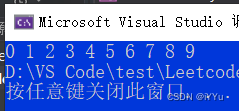
qsort Sort structure members :
struct Stu
{
char name[20];
int age;
};
int cmp_stu_by_name(const void* e1, const void* e2)
{
// utilize strcmp To compare strings
return strcmp( ((struct Stu*)e1)->name, ((struct Stu*)e2)->name );
}
int cmp_stu_by_age(const void* e1, const void* e2)
{
return ((struct Stu*)e1)->age - ((struct Stu*)e2)->age;
}
int main()
{
struct Stu s[] = {
{
"zhangsan", 15}, {
"lisi",20}, {
"wangwu",25} };
int sz = sizeof(s) / sizeof(s[0]);
// Sort by name
qsort(s, sz, sizeof(s[0]), cmp_stu_by_name);
// Sort by age
qsort(s, sz, sizeof(s[0]), cmp_stu_by_age);
return 0;
}
Name sort 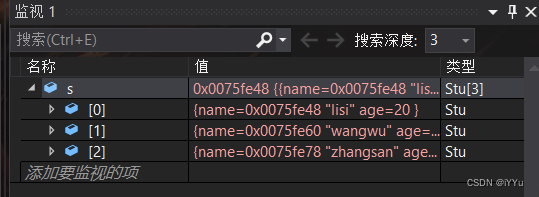
Age ranking :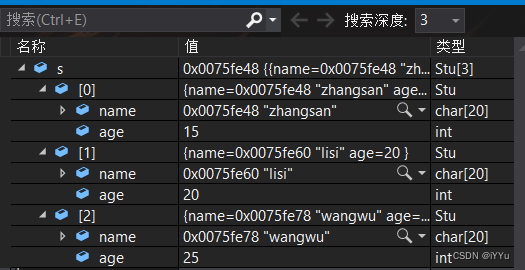
In understanding qsort Use of functions , Next, the ideological transformation based on bubble sorting qsort function :
void Swap(char* p1, char* p2, int width)
{
for (int i = 0; i < width; ++i)
{
char tmp = *p1;
*p1 = *p2;
*p2 = tmp;
++p1;
++p2;
}
}
int cmp_int(const void* e1, const void* e2)
{
return *(int*)e1 - *(int*)e2;
}
void bubble_sort(void* base, int num, int width, int(*cmp)(const void* e1, const void* e2))
{
for (int i = 0; i < num - 1; ++i)
{
int f = 1;
for (int j = 0; j < num - i - 1; ++j)
{
if (cmp( (char*)base + j * width, (char*)base + (j + 1) * width ) > 0)
{
Swap((char*)base + j * width, (char*)base + (j + 1) * width, width);
f = 0;
}
}
if (f == 1)
{
break;
}
}
}
int main()
{
int arr[] = {
9,8,7,6,5,4,3,2,1,0 };
int sz = sizeof(arr) / sizeof(arr[0]);
bubble_sort(arr, sz, sizeof(int), cmp_int);
for (int i = 0; i < sz; ++i)
{
printf("%d ", arr[i]);
}
return 0;
}
Running results :
The above is an in-depth exploration of the pointer , There are many pointer types that can easily be confused if you are not careful , So when learning the pointer, you should carefully and repeatedly watch a lot to master the pointer .
边栏推荐
- Technology sharing | what if Undo is too big
- Redis cluster deployment based on redis5
- #PAT#day10
- 【若依(ruoyi)】ztree 自定义图标(iconSkin 属性)
- My C language learning record (blue bridge) -- under the pointer
- Sign SSL certificate as Ca
- 淘宝焦点图布局实战
- My C language learning record (blue bridge) -- on the pointer
- 2.12 simulation
- Polymorphic day02
猜你喜欢
随机推荐
Selenium share
深入探究指针及指针类型
SD card reports an error "error -110 whilst initializing SD card
全国大学生信息安全赛创新实践赛初赛---misc(永恒的夜)
深度解析指针与数组笔试题
【指针训练——八道题】
多态day02
有没有完全自主的国产化数据库技术
Introduction to robotframework (I) brief introduction and use
Some problem records of AGP gradle
Zhang Lijun: penetrating uncertainty depends on four "invariants"
XSS challenges绕过防护策略进行 XSS 注入
【 kubernets series】 a Literature Study on the Safe exposure Applications of kubernets Service
Solution: attributeerror: 'STR' object has no attribute 'decode‘
Reverse repackaging of wechat applet
【若依(ruoyi)】设置主题样式
Introduction to robotframework (II) app startup of appui automation
解决:AttributeError: ‘str‘ object has no attribute ‘decode‘
What are the principles of software design (OCP)
Distributed service framework dobbo


